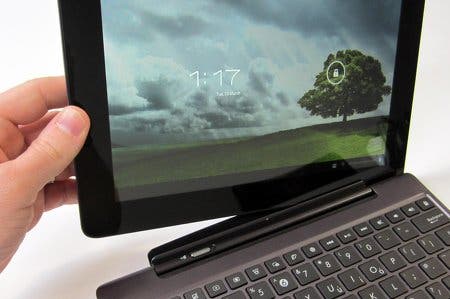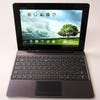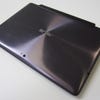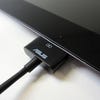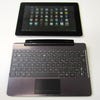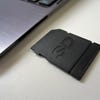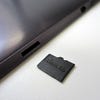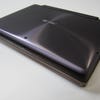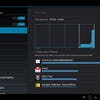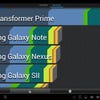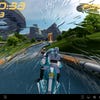Asus Eee Pad Transformer Prime Review
The tablet-laptop hybrid gets a quad core upgrade. Digital Foundry investigates.
Amid the excitement and anticipation generated by the recent New iPad announcement, it's all too easy to forget that Android tablets are already providing bleeding-edge quad core power to the masses. While Apple aficionados drool over the prospect of improved visuals and more immersive gaming possibilities, NVIDIA and Asus have been making good on such promises for most of 2012.
The flagship Android tab of the moment, the Asus Eee Pad Transformer Prime, boasts NVIDIA's powerful Tegra 3 processor - a CPU that dynamically distributes power to each of its four cores, making for a seriously adept piece of kit. It also offers the unique proposition of a desktop and tablet solution for a single price; the keyboard docking station which comes with the tablet grants a full QWERTY setup, complete with track-pad, USB connectivity and even an additional battery.
Despite its long list of plus points, there's never been a harder time to weigh up a potential Transformer Prime purchase. With the New iPad sure to continue Apple's dominance in this sector of electronics, is there really any point in laying out £500 for an also-ran Android? Hopefully by the end of this review, you'll be better equipped to answer that question.
More Than Meets The Eye
Given that the Transformer Prime is being sold on its ability to provide both a tablet and netbook experience, it seems apt to look at this aspect of the device first. Divorced from the keyboard dock, the Prime functions as a standard Android tablet, relying on its Gorilla Glass capacitive touch-screen for interaction. Once docked, the device becomes a touch-and-type hybrid, offering a full keyboard - complete with shortcuts to essential functions - and a track pad, allowing you to make selections on the screen without having to use your fingers.
While it's tempting to assume such a configuration is nothing more than an attempt to carve out a niche in the market which doesn't actually exist, the Transformer Prime performs admirably in both settings. Granted, Android isn't a desktop OS and never will be, but it lends itself surprisingly well to typical desktop tasks. When you consider that Android user accounts are tied in with cloud services such as Google Docs, Calender and Google Mail, what you're essentially getting here is a replication of the much-hyped Chrome Book.
Unlike the previous Transformer, the Prime's external casing is composed almost entirely of metal. As you might expect, this lends the device a premium feel that comfortably rivals that of Apple's iPad. It might seem like a trite comment, but it's worth bearing in mind that very few Android tablets have even come close to matching the output of Cupertino's world-class designers.
With a thickness of just 8.3mm and an overall weight of 586g, the Transformer Prime is also thinner and lighter than Apple's new tablet. Naturally, when you add the keyboard dock those statistics change for the worse, but even so, the Prime is still more svelte than its direct predecessor, which looks positively bulky in comparison.
The Screen to End All Screens and Imaging Greatness
Although the Transformer Prime's 1280x800 display can't compete with the New iPad's eyeball-busting 2048x1536 Retina screen when it comes to packing pixels, it's still one of the best LCDs we've seen on a mobile device. The Super IPS+ tech affords an astonishing degree of brightness and contrast - even in direct sunlight - and viewing angles are absolutely rock-steady. No matter how much you turn and tilt the device, the image is always perfectly legible and insanely bright.
Not only is the Transformer Prime capable of displaying amazing images, it also does an above-average job of capturing them, too. The tablet's size means that it rarely lends itself to impromptu photography or video recording, but the eight megapixel snapper works well enough. The inclusion of auto-focus and LED flash will please budding David Baileys, and the ability to record in 1080p high-definition means that a plethora of awkward yet pin-sharp home movies are within your grasp. It's unlikely that this imaging proficiency is going to encourage many to swap their dedicated cameras for the Prime, but these little extras are welcome all the same.



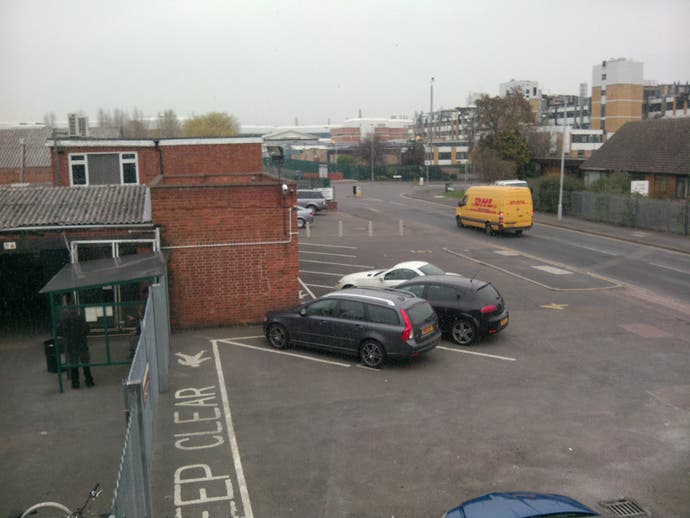
Fearsome Power From a Quad Core Beast
"Although it's advertised as quad core, the Tegra 3 CPU actually has an additional fifth core, limited to a clock speed of 500MHz, performing low-level activities and conserving battery life."
The Transformer Prime is the first of a new wave of quad core Android tablets, and that increase in technological power has predictably brought with it significantly improved, smoother performance. Google's Android platform is tremendously versatile and powerful, but even the most devoted fan would stop short at calling it smooth and completely lag-free. On the Transformer Prime there are still rare pauses and stutters when several processor-intensive applications are running in tandem, but for the most part the experience is slick and responsive.
Although it's advertised as quad core, the Transformer Prime's Tegra 3 CPU actually has an additional fifth core, which is limited to a clock speed of 500MHz and is cunningly able to perform low-level activities and thereby conserve battery life. Even when the four main cores (which can clock up to 1.3GHz when running simultaneously, or 1.4GHz individually) are firing on all cylinders, the Tegra 3 tech is capable of dynamically balancing the workload across each core. All of this basically means that despite the massive increase in raw processing power, NVIDIA's new chip-set is actually more economical on battery life than the dual-core Tegra 2, which was seen in the original Asus Transformer.
To further prolong the lifespan of the tablet's battery, you can employ desktop-style power modes, choosing to limit performance for the sake of increased stamina. Even without the keyboard dock's secondary battery, the Transformer Prime is effortlessly capable of smashing through the 10 hour barrier and beyond; linking the dock allows the tablet to leech even more juice, offering the kind of battery life you'd never expect to see from a traditional laptop.
Room to Expand
Android tablets have always excelled in the area of expansion and connectivity, and the Transformer Prime is no exception. On the tablet itself you'll find a microSD card slot and Micro HDMI-out, and the presence of the keyboard dock affords even more ports to make use of, including 2.0 USB and a SD card slot - not micro SD, but full-size, full-fat SD.
With 32GB of built-in storage as standard, the Prime is hardly short on space, but using the microSD card slot (which resides on the tablet) and the aforementioned SD card slot on the dock, you can boost that figure to incredible heights for very little cash. The USB port on the dock can also be used to plug in memory sticks to add even more space. The lack of a 64GB model of the Prime therefore becomes irrelevant; if you find you need more space, you can simply pick up a 32GB SD card for around £20.
Given the robust nature of the Transformer Prime's expansion options, it's disappointing to note that Asus has stuck with the 40-pin proprietary connector that was used on last year's model. Rivals such as Motorola have wisely moved away from this approach, allowing users to charge its new Xoom 2 tablet with a standardised microUSB cable - the same type that is supplied with practically every non-Apple mobile phone on the planet. Asus' decision means that if you're doing some travelling, you'll need to bung an additional charger in your bag if you plan on taking the Prime along with you.
"The Transformer Prime has 32GB of storage as standard, which can be expanded via microSD on the tablet and a full-size SD slot on the keyboard dock."
Ice Cream in the Offing
Much was made of Asus' decision to launch the Transformer Prime with Android 3.2 (Honeycomb) instead of 4.0 (Ice Cream Sandwich), as many potential buyers had hoped that as well as being the first quad core tablet, it would also be the first to feature Google's shiny new unified operating system. Although it sadly wasn't to be, Ice Cream Sandwich has now been pushed to all UK Transformer Primes; if you purchase one today, chances are you'll be notified of an pending 'over the air' software update when you first switch it on.
At first glance, 4.0 on the Transformer Prime looks an awful lot like 3.2 did. Little embellishments like superior task management and the ability to track data usage are welcome, but overall the most significant improvements are ones you're unlikely to notice unless you're intimately familiar with Honeycomb; 4.0 is more stable and offers better overall performance than its forerunner.
Hard (Quad) Core Gaming
With a quad core CPU and a 12-core GeForce graphics processor concealed beneath that lush aluminium casing, it should come as little surprise to learn that the Transformer Prime is a class apart when it comes to intense 3D visuals - and that means console-quality gaming on a device that is thinner than your average newspaper.
NVIDIA is clearly keen to stress the tablet's strength as a gaming platform, as it includes a custom Tegra Zone application which highlights available games that make use of the additional power provided by the chip. Most of these are games already available on Android which simply harness the strength of the Tegra 3 to boast improved visual effects, but there are some exclusives. Wave Race-wannabe Riptide contains some amazing water effects, while Bladeslinger offers up graphics which would not look out of place on your PS3 or 360 - and running at a higher resolution too. Lamentably, the gameplay isn't comparable, but it offers a tantalising glimpse of just how impressive the Transformer Prime is as a gaming system.
It's here that the tablet's impressive connectivity is called into play. The keyboard dock has a USB port (sadly just the one, unlike the dock seen on the original Transformer, which offered two), into which you can plug a wired 360 pad or a PS3 pad with the USB connection lead attached. Because Android has native controller support, these devices are immediately recognised and do not require any configuration or set-up. Load up the superb Shadowgun, and the controls are automatically mapped. The difference in playing this kind of game on a proper pad compared to a touch-screen is immense; what was previously a rather clumsy affair becomes a visually arresting and hugely enjoyable third-person shooter - and one that is available for the princely sum of £3.49 in its Tegra-supporting guise.
"NVIDIA is keen to stress the tablet's strength as a gaming platform, including a custom Tegra Zone app, highlighting available games that make use of the additional power provided by the chip."
Asus Transformer Prime: The Digital Foundry Verdict
With its combination of gorgeous aesthetics, superior processing power and the very latest Android OS, the Transformer Prime is without a shadow of a doubt the best Android tablet money can buy. Add in the keyboard dock and its ability to turn the tablet into a true laptop replacement, and the package becomes even more irresistible.
However, we all know that in the tablet space, Android isn't calling the shots. Apple's iPad remains the leader in this sector, and when compared to the upgraded model the Transformer Prime's supremacy is less assured. The iPad benefits immeasurably from unparalleled developer support, and has a digital storefront that is literally bursting with apps and games. Android tablet apps are few and far between, and as a rule the Google Play market (formerly known as the Android Market) is usually a few months behind the App Store when it comes to essential downloads.
Apple is even claiming that it has technological dominance over the Transformer Prime, going as far as to state that the New iPad's A5X chip offers four times the power of the Tegra 3. This boast has been made without any solid evidence or reliable benchmarking and is therefore impossible to substantiate at the moment, but it's reasonable to assume that games on the New iPad will look as good - if not better - than those on the Transformer Prime.
Still, the iPad isn't for everyone. If you're looking for an alternative tablet which is flexible, powerful, has incredible battery life and comes bristling with expansion options, then this is your dream ticket. [Updated: correct iPad pricing added] When you consider it retails for only a little more than the mid-range 32GB WiFi version of the new iPad, the deal becomes even more attractive - the only cloud on the horizon is the forthcoming release of its successor, the Transformer Pad Infinity, which packs a higher resolution display.
